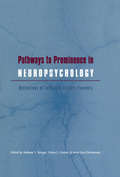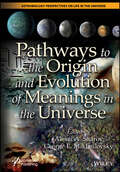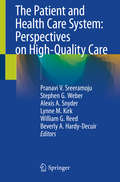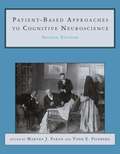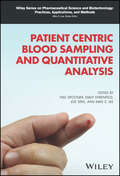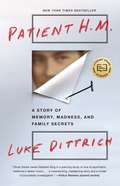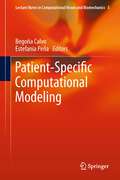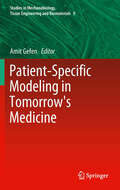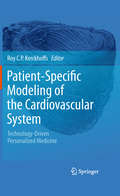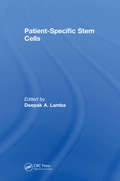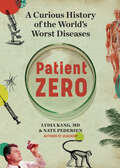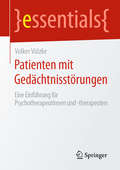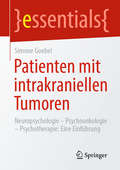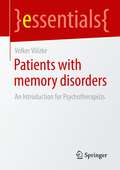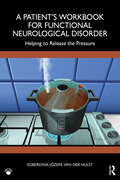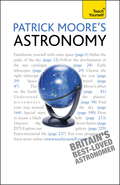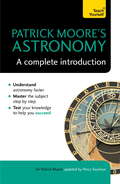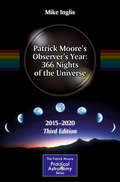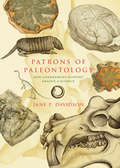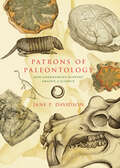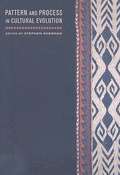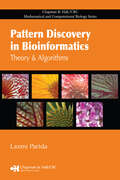- Table View
- List View
Pathways to Prominence in Neuropsychology: Reflections of Twentieth-Century Pioneers
by Anthony Y. Stringer Eileen L. Cooley Anne-Lise ChristensenCaptures the stories behind the work of the clinicians and scholars who have contributed significantly to neuropsychology's development.
Pathways to the Origin and Evolution of Meanings in the Universe (Astrobiology Perspectives on Life in the Universe)
by Alexei A. Sharov George E. MikhailovskyPathways to the Origin and Evolition of Meanings in the Universe The book explains why meaning is a part of the universe populated by life, and how organisms generate meanings and then use them for creative transformation of the environment and themselves. This book focuses on interdisciplinary research at the intersection of biology, semiotics, philosophy, ethology, information theory, and the theory of evolution. Such a broad approach provides a rich context for the study of organisms and other semiotic agents in their environments. This methodology can be applied to robotics and artificial intelligence for developing robust, adaptable learning devices. In this book, leading interdisciplinary scholars reveal their vision on how to integrate natural sciences with semiotics, a theory of meaning-making and signification. Developments in biology indicate that the capacity to create and understand signs is not limited to humans or vertebrate animals, but exists in all living organisms - the fact that inspired the integration of biology and semiotics into biosemiotics. The authors discuss the nature of semiotic agents (organisms and other autonomous goal-directed units), meaning, signs, information, memory, evolution, and consciousness. Also discussed are issues including the origin of life, potential meaning and its actualization, top-down causality in physics and biology, capacity of organisms to encode their functions, the strategy of organisms to combine homeostasis with direct adaptation to new life-cycle phases or new environments, multi-level memory systems, increase of freedom via enabling constraints, creative modeling in evolution and learning, communication in animals and humans, the origin and function of language, and the distribution and transfer of life in space. This is the first book on biosemiotics in its global conceptual and spatial scope. Biosemiotics is presented using the language of natural sciences, which supports the scientific grounding of semiotic terms. Finally, the cosmic dimension of life and meaning-making leads to a reconsideration of ethical principles and ecological mentality here on earth and in space exploration. Audience Theoretical biologists, ethologists, astrobiologists, ecologists, evolutionary biologists, philosophers, phenomenologists, semioticians, biosemioticians, molecular biologists, linguists, system scientists and engineers.
The Patient and Health Care System: Perspectives on High-Quality Care
by Pranavi V. Sreeramoju Stephen G. Weber Alexis A. Snyder Lynne M. Kirk William G. Reed Beverly A. Hardy-DecuirThis book focuses on the interface between the patient and the healthcare system as the entryway to high-quality care and improved outcomes. Unlike other texts, this book puts the patient back in the center of care while integrating the various practices and challenges. Written by interdisciplinary experts, the book begins by evaluating the entire quality landscape before giving voice to all parties involved, including physicians, nurses, administrators, patients, and families. The text then focuses on how to develop a structure that meets needs of all of these groups, effectively addressing common threats to positive outcomes and patient satisfaction. The text tackles the most common challenges clinicians face in a hospital setting, including infection prevention, medication error and stewardship that may jeopardize recovery, complex care, and employee-patient engagement.The Patient and Healthcare System: Perspectives on High-Quality Care is an excellent resource for physicians across broad specialties, nurses, hospital administrators, social workers, patient caregivers and all healthcare professionals concerned with infection prevention, quality and safety of care delivery, and patient satisfaction.
Patient-based Approaches to Cognitive Neuroscience (2nd edition)
by Martha J. Farah Todd E. FeinbergIn addition to the updated coverage of perception, attention, memory, language, executive function, and development, the new edition includes expanded material on functional neuroimaging of normal subjects and of neurological patients, electrophysiological methods including TMS, and the genetics of neurocognitive disorders.
Patient Centric Blood Sampling and Quantitative Analysis (Wiley Series on Pharmaceutical Science and Biotechnology: Practices, Applications and Methods)
by Neil Spooner Emily Ehrenfeld Joe Siple Mike S. LeePATIENT CENTRIC BLOOD SAMPLING AND QUANTITATIVE ANALYSIS Authoritative resource providing a complete overview of patient centric blood sampling, as well as its benefits and challenges Patient Centric Blood Sampling and Quantitative Analysis focuses on the growing interest in alternative means to standard phlebotomy and analytical workflows for the collection and analysis of high-quality human biological samples for the quantitative determination of circulating drugs, their metabolites, and endogenous substances for clinical trials, routine healthcare and neonatal screening. The book clearly explains the benefits and constraints of having patients collect small volumes of blood in locations outside of a clinic (e.g at home), including: patient convenience; less invasive procedures; increased frequency of sampling; applicability to collecting samples from the young, elderly, and those in remote locations; greater frequency; and lower cost per sample. Readers will learn about approaches for successfully implementing patient centric sampling workflows in a number of scenarios, including the clinical setting and in the analytical laboratory. Edited by four recognized experts in this field, with additional specialists in the discipline enlisted to write the component chapters, enabling greater depth and detail to be added and further raising the scientific standing of the publication, Patient Centric Blood Sampling and Quantitative Analysis includes information on: Basics of patient centric blood sampling and techniques and approaches that are available and in development for the collection and analysis of the samples Science behind patient centric blood sampling and its implications regarding human healthcare and wellbeing Application areas of patient centric sampling, including drug development, clinical chemistry/pathology, therapeutic drug monitoring, and more Practical approaches to successful implementation for existing and developing purposes and workflows, and case studies to support implementation within an organization Giving the reader a broad understanding of what patient centric sampling is and where it might be applied for existing and potential future areas, Patient Centric Blood Sampling and Quantitative Analysis is an essential resource on the subject for many different types of laboratories, areas of clinical research and healthcare, including those in pharmaceutical, clinical, and research functions.
Patient Compliance with Medications: Issues and Opportunities
by Richard SchulzImprove your patient&’s health through a fresh view of their behaviorsPatients who use over-the-counter (OTC) and prescription medicine often do not take the drugs as intended, sometimes to the detriment to their health and well-being. These widespread problems cause health professionals to agonize over how to try to make sure pati
Patient H.M.: A Story of Memory, Madness, and Family Secrets
by Luke Dittrich"Oliver Sacks meets Stephen King"* in this propulsive, haunting journey into the life of the most studied human research subject of all time, the amnesic known as Patient H.M., a man who forever altered our understanding of how memory works--and whose treatment raises deeply unsettling questions about the human cost of scientific progress. For readers of The Immortal Life of Henrietta Lacks comes a story that has much to teach us about our relentless pursuit of knowledge. *Kirkus Reviews (starred review) In 1953, a twenty-seven-year-old factory worker named Henry Molaison--who suffered from severe epilepsy--received a radical new version of the then-common lobotomy, targeting the most mysterious structures in the brain. The operation failed to eliminate Henry's seizures, but it did have an unintended effect: Henry was left profoundly amnesic, unable to create long-term memories. Over the next sixty years, Patient H.M., as Henry was known, became the most studied individual in the history of neuroscience, a human guinea pig who would teach us much of what we know about memory today. Patient H.M. is, at times, a deeply personal journey. Dittrich's grandfather was the brilliant, morally complex surgeon who operated on Molaison--and thousands of other patients. The author's investigation into the dark roots of modern memory science ultimately forces him to confront unsettling secrets in his own family history, and to reveal the tragedy that fueled his grandfather's relentless experimentation--experimentation that would revolutionize our understanding of ourselves. Dittrich uses the case of Patient H.M. as a starting point for a kaleidoscopic journey, one that moves from the first recorded brain surgeries in ancient Egypt to the cutting-edge laboratories of MIT. He takes readers inside the old asylums and operating theaters where psychosurgeons, as they called themselves, conducted their human experiments, and behind the scenes of a bitter custody battle over the ownership of the most important brain in the world. Patient H.M. combines the best of biography, memoir, and science journalism to create a haunting, endlessly fascinating story, one that reveals the wondrous and devastating things that can happen when hubris, ambition, and human imperfection collide.Praise for Patient H.M."An exciting, artful blend of family and medical history."--The New York Times"Patient H.M. tells one of the most fascinating and disturbing stories in the annals of medicine, weaving in ethics, philosophy, a personal saga, the history of neurosurgery, the mysteries of human memory, and an exploration of human ego."--Sheri Fink, M.D., Pulitzer Prize winner and author of Five Days at Memorial "Dittrich explores the limits of science and the mind. In the process, he rescues an iconic life from oblivion. Dittrich is well aware that while we are the sum of what we may remember, we're also at the mercy of what we can forget. This is classic reporting and myth-making at the same time."--Colum McCann, author of Let the Great World Spin "This book succeeds on every level: as a fresh look at the most famous patient in medical history, as an exposé of our dark history of psychiatry and neurosurgery, and, most powerfully, as a deeply personal investigation into the author's past. And yet it's still a page-turner that reads like a thriller."--Susannah Cahalan, author of Brain on FireFrom the Hardcover edition.
Patient-Specific Computational Modeling
by Begoña Calvo Lopez Estefanía PeñaThis book addresses patient-specific modeling. It integrates computational modeling, experimental procedures, imagine clinical segmentation and mesh generation with the finite element method (FEM) to solve problems in computational biomedicine and bioengineering. Specific areas of interest include cardiovascular problems, ocular and muscular systems and soft tissue modeling. Patient-specific modeling has been the subject of serious research over the last seven years and interest in the area is continually growing and this area is expected to further develop in the near future.
Patient-Specific Modeling in Tomorrow's Medicine
by Amit GefenThis book reviews the frontier of research and clinical applications of Patient Specific Modeling, and provides a state-of-the-art update as well as perspectives on future directions in this exciting field. The book is useful for medical physicists, biomedical engineers and other engineers who are interested in the science and technology aspects of Patient Specific Modeling, as well as for radiologists and other medical specialists who wish to be updated about the state of implementation.
Patient-Specific Modeling of the Cardiovascular System
by Roy C.P. KerckhoffsThe main purpose of the book is to demonstrate the design of a variety of patient-specific models within the cardiovascular system in computational biology. The maturation of computational biology could lead to a new approach to medicine. During the last five to ten years, there have been many improvements in diagnostic medical technologies such as multi-slice cardiac CT imaging, 3-D electroanatomic mapping, and many types of applications of Magnetic Resonance Imaging (i.e. magnetic resonance tagging and diffusion tensor imaging). Combined with more powerful computing resources and more accurate predictive computational models it is feasible to begin developing mechanistic patient-specific models that may help diagnosis, guide therapy or surgery, and predict outcomes of the latter. Many questions need to be answered before computational modeling can be fully integrated with standard care, such as what is the minimal data set needed from the patient in order to build a reliable predictive model? What accuracy is needed? How will the initial baseline model be validated? What are reasonable computation times? Is some type of perturbation of the patient's physiology necessary? How could they be integrated with current practices? Are physicians willing to accept these models? These questions will also serve as guidelines throughout the chapters. The book will try to cover, such as cardiac electrophysiology, cardiac (muscle) mechanics, circulation dynamics, arterial and venous flow, angiogenesis, remodeling, metabolism, or combinations between these such as cardiac electromechanics or fluid-solid interactions.
Patient-Specific Stem Cells
by Deepak A. LambaOne of the biggest challenges faced in medical research had been to create accurate and relevant models of human disease. A number of good animal models have been developed to understand the pathophysiology. However, not all of them reflect the human disorder, a classic case being Usher’s syndrome where the mutant mice do not have the same visual and auditory defects that patients face. There are others which have been even more difficult to model due to the multi-factorial nature of the condition and due to lack of discovery of a single causative gene such as age-related macular degeneration or Alzheimer’s syndrome. Thus a more relevant and accurate system will allow us to make better predictions on relevant therapeutic approaches. <P><P>The discovery of human pluripotent stem cells in 1998 followed by the technological advances to reprogram somatic cells to pluripotent-stem cell-like cells in 2006 has completely revolutionized the way we can now think about modelling human development and disease. This now coupled with genome editing technologies such as TALENS and CRISPRs have now set us up to develop in vitro models both 2D as well as 3D organoids, which can more precisely reflect the disease in the patients. These combinatorial technologies are already providing us with better tools and therapeutics in drug discovery or gene therapy. <P><P>This book summarizes both the technological advances in the field of generation of patient specific lines as well as various gene editing approaches followed by its applicability in various systems. The book will serve as a reference for the current state of the field as it: <li>Provides a comprehensive overview of the status of the field of patients derived induced pluripotent stem cells. <li>Describes the use of cardiac cells as a main featured component within the book. <li>Examines drug toxicity analysis as a working example throughout the book.
Patient Zero: A Curious History of the World's Worst Diseases
by Lydia Kang Nate PedersenFrom the masters of storytelling-meets-science and co-authors of Quackery, Patient Zero tells the long and fascinating history of disease outbreaks—how they start, how they spread, the science that lets us understand them, and how we race to destroy them before they destroy us. Written in the authors&’ lively and accessible style, chapters include page-turning medical stories about a particular disease or virus—smallpox, Bubonic plague, polio, HIV—that combine &“Patient Zero&” narratives, or the human stories behind outbreaks, with historical examinations of missteps, milestones, scientific theories, and more. Learn the tragic stories of Patient Zeros throughout history, such as Mabalo Lokela, who contracted Ebola while on vacation in 1976, and the Lewis Baby on London&’s Broad Street, the first to catch cholera in an 1854 outbreak that led to a major medical breakthrough. Interspersed are origin stories of a different sort—how a rye fungus in 1951 turned a small village in France into a phantasmagoric scene reminiscent of Burning Man. Plus the uneasy history of human autopsy, how the HIV virus has been with us for at least a century, and more.
Patienten mit Gedächtnisstörungen: Eine Einführung für Psychotherapeutinnen und -therapeuten (essentials)
by Volker VölzkeGedächtnisstörungen im Alltag beeinträchtigen die Lebensqualität der Betroffenen und haben auch Auswirkungen auf die therapeutische Vorgehensweise. Kenntnisse zu Diagnostik, Therapie und Kompensation von Gedächtnisstörungen unterschiedlicher Verursachung verbessern die therapeutischen Möglichkeiten in bedeutsamer Weise. Volker Völzke vermittelt in diesem essential praxisbezogenes Basiswissen: Welche Diagnostik und welche Hilfsmittel gibt es und was bedeuten die Gedächtnisdefizite für die Therapie und Beratung? Kann eine Psychotherapie mit Menschen mit Gedächtnisstörungen überhaupt erfolgreich durchgeführt werden? Wie können Personen, die Patienten mit Gedächtnisstörungen versorgen, qualifiziert unterstützt und beraten werden?
Patienten mit intrakraniellen Tumoren: Neuropsychologie – Psychoonkologie – Psychotherapie: Eine Einführung (essentials)
by Simone GoebelDieses essential gibt einen Kurzüberblick über psychosoziale Aspekte von Patienten mit Hirntumoren. Die Arbeit mit dieser besonderen Patientengruppe erfordert spezifische Kenntnisse in den Bereichen Neuropsychologie, Psychoonkologie und Psychotherapie, die praxisnah vermittelt werden. Patienten mit intrakraniellen Tumoren zählen zu den am stärksten belasteten Patientengruppen überhaupt. Sie sind nicht nur von allen Belastungsfaktoren onkologischer Erkrankungen betroffen, zu welchen zum Beispiel die langwierige und nebenwirkungsreiche medizinische Therapie oder die oft verringerte Lebenserwartung zählen, sondern auch von allen Belastungsfaktoren neurologischer Erkrankungen, worunter auch neuropsychologische Veränderungen wie kognitive Defizite, eine verminderte Kommunikationsfähigkeit und organisch bedingte Persönlichkeitsveränderungen fallen.
Patients with Memory Disorders: An Introduction for Psychotherapists (essentials)
by Volker VölzkeMemory disorders in everyday life impair the quality of life of those affected and also have an impact on the therapeutic approach. Knowledge of the diagnosis, therapy and compensation of memory disorders of various causes significantly improves the therapeutic options. Volker Völzke imparts in this essential practice-related basic knowledge: What diagnostics and what tools are available and what do memory deficits mean for therapy and counselling? Can psychotherapy with people with memory disorders be carried out successfully at all? How can people who care for patients with memory disorders be given qualified support and advice?
A Patient’s Workbook for Functional Neurological Disorder: Helping To Release the Pressure
by Egberdina-Józefa van der HulstThis self-help workbook offers guidance for people coping with functional neurological disorder (FND), as well as their partners, families, friends, and healthcare professionals. It uses a visual metaphor based on the groundbreaking new Pressure Cooker Model to help you understand the condition and to reduce the symptoms. Firmly rooted in neuropsychological principles, this model is practical and relatable, bridging the gap between theoretical and clinical models of FND.The Pressure Cooker Model focuses on the person with FND, as well as the contribution of the person’s environment, interactions, relationships, and surroundings to FND, and looks to improve recovery, reduce stigma and increase FND awareness, providing a radical shift in thinking about FND. Grounded in neuropsychology, this book helps people understand their FND triggers, as well as their emotional and physical symptoms, and offers many strategies for self-care and building healthy relationships.The book is accompanied by an extensive set of entirely free online resources and templates to help people with FND manage a range of genuine and disabling functional neurological symptoms, from motor symptoms (such as tremors, functional weakness, and gait difficulties, to sensory symptoms such as tingles and numbness, and cognitive symptoms such as memory and concentration difficulties or brain fog, and dissociative seizures. It is valuable reading for anyone with FND, their partners, families, and friends, as well as healthcare professionals in any field working with people with FND.
Patrick Moore's Astronomy: Teach Yourself
by Patrick MoorePatrick Moore's Astronomy will ensure you recognize what you are seeing in the night sky. You will investigate the sun, moon, planets comets and stars and learn how to observe them. This comprehensive guide, complete with star charts, will map out the skies and allow you to impress your friends with your knowledge of the sky at night.NOT GOT MUCH TIME?One, five and ten-minute introductions to key principles to get you started.AUTHOR INSIGHTSLots of instant help with common problems and quick tips for success, based on the author's many years of experience.TEST YOURSELFTests in the book and online to keep track of your progress.EXTEND YOUR KNOWLEDGEExtra online articles at www.teachyourself.com to give you a richer understanding of astronomy.FIVE THINGS TO REMEMBERQuick refreshers to help you remember the key facts.TRY THISInnovative exercises illustrate what you've learnt and how to use it.
Patrick Moore's Astronomy: Teach Yourself
by Patrick Moore Percy SeymourAstronomy: A Complete Introduction will ensure you recognize what you are seeing in the night sky. You will investigate the sun, moon, planets comets and stars and learn how to observe them. This comprehensive guide, complete with star charts, will map out the skies and allow you to impress your friends with your knowledge of the sky at night. Astronomy: A Complete Introduction includes: Chapter 1: Introducing Astronomy Chapter 2: The spinning sky Chapter 3: Sky-watchers Chapter 4: The astronomer's telescope Chapter 5: Into space Chapter 6: The Sun Chapter 7: The Moon Chapter 8: The Sun's family Chapter 9: The inner planets Chapter 10: The outer planets Chapter 11: Minor members of the Solar System Chapter 12: The stars Chapter 13: Pattern of stars Chapter 14: Double and variable stars Chapter 15: The life and times of a star Chapter 16: The Star-clusters and nebulae Chapter 17: The depths of the universe Chapter 18: Into the future - life beyond the Earth
Patrick Moore's Astronomy: A Complete Introduction: Teach Yourself
by Sir Patrick Moore Percy SeymourAstronomy: A Complete Introduction will ensure you recognize what you are seeing in the night sky. You will investigate the sun, moon, planets comets and stars and learn how to observe them. This comprehensive guide, complete with star charts, will map out the skies and allow you to impress your friends with your knowledge of the sky at night.Astronomy: A Complete Introduction includes:Chapter 1: Introducing AstronomyChapter 2: The spinning skyChapter 3: Sky-watchersChapter 4: The astronomer's telescopeChapter 5: Into spaceChapter 6: The SunChapter 7: The MoonChapter 8: The Sun's familyChapter 9: The inner planetsChapter 10: The outer planetsChapter 11: Minor members of the Solar SystemChapter 12: The starsChapter 13: Pattern of starsChapter 14: Double and variable starsChapter 15: The life and times of a starChapter 16: The Star-clusters and nebulaeChapter 17: The depths of the universeChapter 18: Into the future - life beyond the Earth
Patrick Moore's Observer's Year: 366 Nights of the Universe
by Mike InglisObservers no longer need to wonder what they will turn their attention to each night of the year with this updated text of a beloved favorite from Sir Partick Moore. His night-by-night account of the stars is the best possible guide an observer could ask for, and now includes the latest data for the years 2015-2020, preserving and extending Sir Patrick Moore's legacy. This new edition of his classic text makes it easy to see why Sir Patrick Moore was such a helpful guide to generations of budding astronomers, professional and amateur alike. For every night of the year Patrick gives the reader details of interesting objects that can be seen from Earth. It is a book for people with a wide interest in practical astronomy, those who may not have specialized in a specific area of astronomy and wish to expand their knowledge in all areas. Moore updated his book in a second edition in 2005, giving astronomical events through 2010, but a more current version has been desperately lacking. This third edition includes Sir Patrick's original text but revises its time-sensitive material and adds all of the points of interest that change from year to year, such as eclipses, occultations, planetary positions, and so on. Sir Patrick Moore left behind an enormous legacy, including the world's longest-running television series with the same original presenter, the BBC's The Sky at Night, and more than 70 written works. His influence on the world of amateur astronomy was phenomen al, and his knowledge and passion led many to take up observing as a life-long hobby. This book, "The Observer's Year, 366 Nights of the Universe" was, he said, one of his personal favorites. It now features a tribute to Patrick Moore's legacy as well as including what has changed in astronomy since the previous edition ten years ago.
Patrones Crecientes (Growing Patterns): Los números de Fibonacci en la naturaleza
by Sarah C. CampbellAn ALSC Notable Children's BookA wondrous introduction to one of the most beautiful connections between mathematics and the natural world—the Fibonacci sequence—through a series of stunning nature photographs.Discover the biggest mathematical mystery in nature—Fibonacci numbers! Named after a famous mathematician, the number pattern is simple and starts with: 1, 1, 2, 3, 5, 8, 13. Each number in the sequence comes from adding the two numbers before it. What's the mystery? The pattern crops up in the most unexpected places. You'll find it in the disk of a sunflower, the skin of a pineapple, and the spiral of a nautilus shell. This book brings math to life, celebrates science, and inspires kids to see nature through new eyes.
Patrons of Paleontology: How Government Support Shaped a Science
by Jane P. DavidsonIn the 19th and early 20th centuries, North American and European governments generously funded the discoveries of such famous paleontologists and geologists as Henry de la Beche, William Buckland, Richard Owen, Thomas Hawkins, Edward Drinker Cope, O. C. Marsh, and Charles W. Gilmore. In Patrons of Paleontology, Jane Davidson explores the motivation behind this rush to fund exploration, arguing that eagerness to discover strategic resources like coal deposits was further fueled by patrons who had a genuine passion for paleontology and the fascinating creatures that were being unearthed. These early decades of government support shaped the way the discipline grew, creating practices and enabling discoveries that continue to affect paleontology today.
Patrons of Paleontology: How Government Support Shaped a Science (Life of the Past)
by Jane P. DavidsonA history of North American and European governments supporting paleontology in the nineteenth and twentieth centuries, and the motivation behind it.In the nineteenth and early twentieth centuries, North American and European governments generously funded the discoveries of such famous paleontologists and geologists as Henry de la Beche, William Buckland, Richard Owen, Thomas Hawkins, Edward Drinker Cope, O. C. Marsh, and Charles W. Gilmore. In Patrons of Paleontology, Jane Davidson explores the motivation behind this rush to fund exploration, arguing that eagerness to discover strategic resources like coal deposits was further fueled by patrons who had a genuine passion for paleontology and the fascinating creatures that were being unearthed. These early decades of government support shaped the way the discipline grew, creating practices and enabling discoveries that continue to affect paleontology today.“This slim book, graced with beautiful facsimile reproductions of gorgeous paleontological folio art, is a treasure trove of vertebrate paleontological history, sacred and arcane.” —The Quarterly Review of Biology“Patrons of Paleontology is a good introduction to the ambitious individuals and institutions that pursued their own, national, and institutional interests over centuries in a variety of contexts.” —Journal of American History“Who pays for palaeontological research and why? Patrons of Paleontology will be a useful reference guide for anyone interested in the early history of the subject and some of the social and historical context in which it occurred.” —Paul Barrett, Priscum, The Newsletter of the Palentological Society
Pattern and Process in Cultural Evolution
by Stephen ShennanThis volume offers an integrative approach to the application of evolutionary theory in studies of cultural transmission and social evolution and reveals the enormous range of ways in which Darwinian ideas can lead to productive empirical research, the touchstone of any worthwhile theoretical perspective. While many recent works on cultural evolution adopt a specific theoretical framework, such as dual inheritance theory or human behavioral ecology,Pattern and Process in Cultural Evolution emphasizes empirical analysis and includes authors who employ a range of backgrounds and methods to address aspects of culture from an evolutionary perspective. Editor Stephen Shennan has assembled archaeologists, evolutionary theorists, and ethnographers, whose essays cover a broad range of time periods, localities, cultural groups, and artifacts.
Pattern Discovery in Bioinformatics: Theory & Algorithms
by Laxmi ParidaThe computational methods of bioinformatics are being used more and more to process the large volume of current biological data. Promoting an understanding of the underlying biology that produces this data, Pattern Discovery in Bioinformatics: Theory and Algorithms provides the tools to study regularities in biological data.Taking a systema
